FY2021 Annual Report
Light-Matter Interactions for Quantum Technologies Unit
Professor Síle Nic Chormaic

Abstract
FY2021 was another challenging year due to the ongoing pandemic, putting a pause on many of our collaborative projects and leading to serious barricades in bringing researchers to OIST and having continuation on our experimental endeavours. Despite this, we remained COVID-free, were able to work almost the entire year in our laboratories (apart from 2 weeks of OIST closure) and we produced several new results. We also progressed on the trapping of the "very small" using plasmonic metamaterial devices designed in-house. While a quieter year in many respects than previous pre-COVID years since we had no visitors to OIST and almost all travel from OIST was stopped, our work progressed within these limitations. Our major research outputs are discussed below. We also had our 5-year research review that we passed very successfully.
1. Staff
Research Staff
- Dr. Dylan Brown, Postdoctoral Scholar
- Dr. Jesse Everett, Postdoctoral Scholar
- Dr. Jameesh Keloth, Postdoctoral Scholar
- Dr. Domna Kotsifaki, Staff Scientist (until December 2021)
- Dr. Shilong Li, Staff Scientist
- Dr. Ke Tian, Postdoctoral Scholar (until January 2021)
- Dr. Georgiy Tkachenko, Staff Scientist (until March 2022)
- Dr. Viet Giang Truong, Group Leader/Staff Scientist
Support Staff
- Dr. Kristoffer Karlsson, Technician
- Ms. Emi Nakamura, Research Unit Administrator
- Mr. Metin Ozer, Technician
PhD Students
- Theodoros Bouloumis, OIST PhD student
- Cindy Esporlas, OIST PhD student
- Ratnesh Kumar Gupta, OIST PhD student
- Mohammed Zia Jalaludeen (from September 2021)
- Maki Maeda, OIST PhD student
- Aswathy Raj (from September 2021)
- Lewis Ruks, OIST PhD student (co-supervision)
- Zohreh Shahrabifarahani, OIST PhD student
- Alexey Vylegzhanin, OIST PhD student
Rotation/Intern Students/Visiting Research Student
- Prajakta Kokate, Rotation Student (January-April 2021)
- Aswathy Raj, Rotation Student (January-April 2021)
- Mohammed Zia Jalaludeen, Rotation Student (May-August 2021)
- Jennifer Sanchez, Remote Research Intern (March 2022)
2. Collaborations
- Theme: Plasmonic trapping of nanoparticles
- Type of collaboration: Joint research
- Researchers:
- D. Kotsifaki (Duke Kunshan University, China)
- Theme: Transverse spin effects
- Type of collaboration: Joint research
- Researchers:
- M. Petrov (ITMO, Russia)
- I. Toftul (ITMO, Russia)
- G. Tkachenko (Tokyo University of Science, Japan)
- Theme: Blue comb using WGM resonators
- Type of collaboration: Joint research
- Researchers:
- F. Lei (Chalmers University, Sweden)
- J. Ward (UCC, Ireland)
- K. Tian (Harbin Engineering University, China)
- Theme: Nanoparticle trapping using novel optical fibres
- Type of collaboration: Joint research
- Researchers:
- J. Fick (Institut Neel, France)
- H. Giessen (University of Stuttgart, France)
- Theme: Rydberg atoms and optical nanofibres
- Type of collaboration: Joint research
- Researchers:
- E. Brion (University of Toulouse, France)
- J. Robert (ENS Paris Saclay, France)
- K. Moelmer (Aarhus University, Denmark)
- Theme: Nonlinear materials for WGM resonators
- Type of collaboration: Joint research
- Researchers:
- P. Wang (Harbin Engineering University, China)
- K. Tian (Harbin Engineering University, China)
- Theme: WGM-based photothermal imaging
- Type of collaboration: Joint research
- Researchers:
- R. Goldsmith (University of Wisconsin, Madison, USA)
- Theme: Microbubbles for phase changes
- Type of collaboration: Joint research
- Researchers:
- T. Carmon (Technion, now Tel-Aviv University, Israel)
- Theme: Neutral atoms and optical nanofibres
- Type of collaboration: Joint research
- Researchers:
- T. Busch and F. Le Kien (Quantum Systems Unit, OIST)
- D. Kornovan (ITMO, Russia & Aarhus University, Denmark)
3. Activities and Findings
3.1 Packaged whispering gallery resonator device based on an optical nanoantenna coupler
In order to improve the practical prospect of whispering gallery mode (WGM) microcavity devices, the packaging of WGM microcavity devices has become a research hotspot. Here, we proposed a packaged WGM device (Fig. 1) based on an optical nanoantenna as the coupler and a glass microsphere as the resonator. The microspheres were fabricated from either SiO2 fiber or Er3+-doped fiber, the latter creating a WGM laser with a threshold of 93 μW at 1531 nm. The coupler-resonator WGM device was packaged in a glass capillary. The performance of the packaged microlaser was characterized, with lasing emission both excited in and collected from the WGM cavity via the nanoantenna. The packaged system provides isolation from environmental contamination, a small size, and unidirectional coupling while maintaining a high quality (Q-) factor (~108).
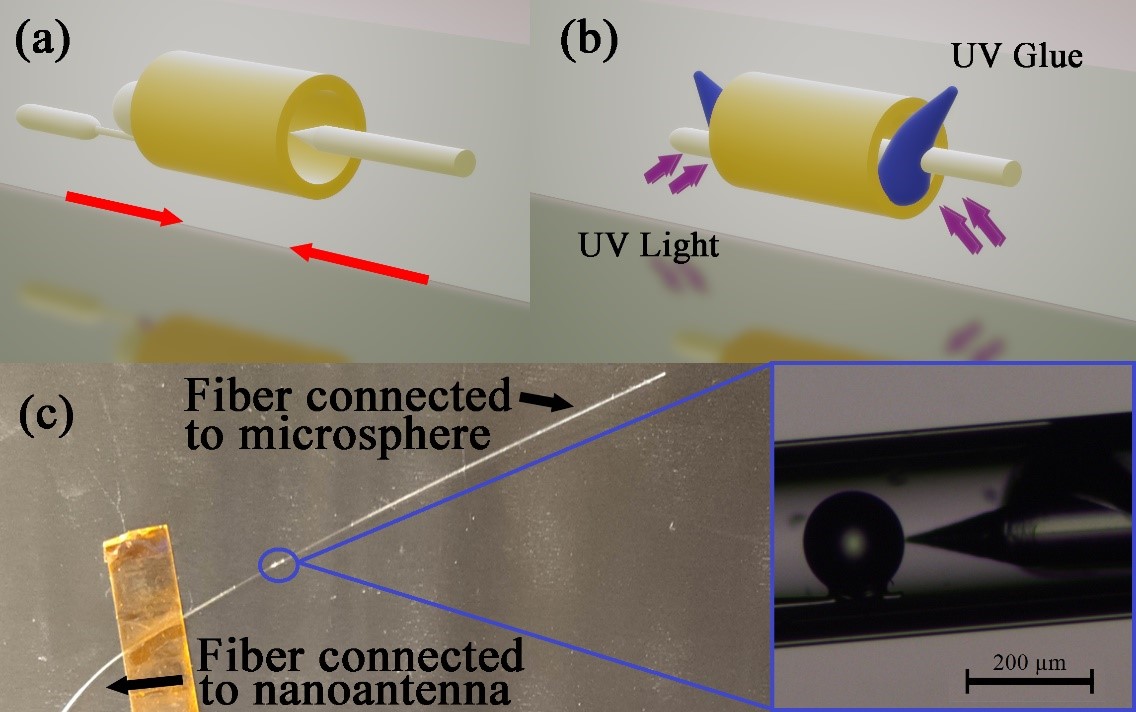
Figure 1: Packaging process. (a) The microsphere and nanoantenna are inserted into a short capillary tube and adjusted in position. (b) The two sides of the capillary are sealed with UV glue and irradiated by UV light (c) A packaged device. The zoomed-in image shows a packaged structure in detail.
Publication:
Packaged whispering gallery resonator device based on an optical nanoantenna coupler
A Li, K Tian, J Yu, RA Minz, JM Ward, S Mondal, P Wang and S Nic Chormaic
Opt. Express 29, 16879 (2021)
3.2 Raman optical tweezers for microplastic pollution identification in the surface waters of Okinawa
Marine plastic debris is a widely recognized environmental issue. By employing an optical micro-Raman tweezers setup, we have identified the composition of particles trapped in marine aggregates collected from the coastal surface waters around the subtropical island of Okinawa, Japan. This chemical identification of small microplastics at the single-particle level contributes to extending our knowledge of plastic pollution in the ocean around a Blue Zone region, see Fig. 2.
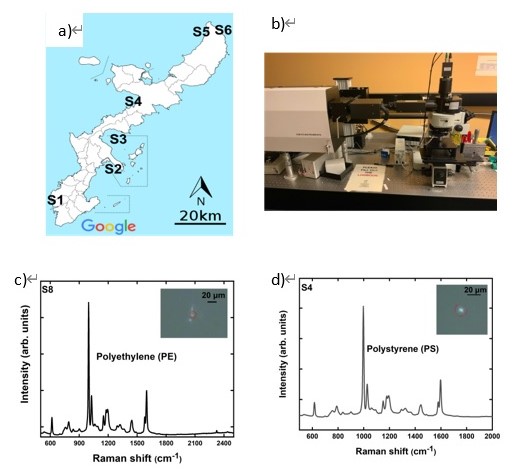
Figure 2: (a) Map of the main island of Okinawa. The six stations from where surface water samples were collected and analyzed are labeled. (b)Image of the optical tweezers micro-Raman spectroscopy that was used to analyze collected surface water samples in their seawater environment. (c), (d) Raman spectra of optically trapped microplastic particles diluted in seawater with optical images as insets. The red circle indicates the trapped microplastics. (c) Polythylene spectrum (PE) with additional peaks most likely from dyes or additives that are commonly found in this microplastic. (d) Polystyrene spectrum (PS) of 5 μm diameter microplastic.
Publication:
Raman optical tweezers for microplastic pollution identification in the surface waters of Okinawa
DG Kotsifaki, C Ripken and S Nic Chormaic
Proc. SPIE 11798, Optical Trapping and Optical Manipulation XVIII, 1179829 (1 August 2021)
3.3 Analysis of small plastics in coastal surface water samples of Okinawa using optical tweezers-Raman spectroscopy
In this work, we have employed an optical trapping-Raman spectroscopy technique for simultaneous characterization and monitoring of the physical and chemical properties of single small micro-plastics in a seawater environment (see figure below). Through analysis of the data, we have chemically identified the plastic and have distinguished it from organic matter and/or mineral sediments. Additionally, we have categorized the particles based on their size and shapes such as beads, fragments, and fibers. The proposed technique paves the way to understand the fragmentation process of aged polymers, as well as to monitoring marine plastic pollution.
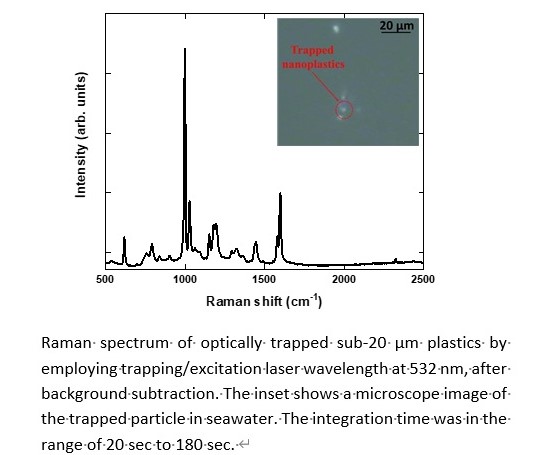
Publication:
Analysis of small plastics in coastal surface water samples of Okinawa using optical tweezers-Raman spectroscopy
DG Kotsifaki, C Ripken and S Nic Chormaic
Proc. SPIE 11926, Optical Manipulation and Structured Materials Conference 2021, 119260J (27 October 2021)
3.4 1.6 GHz frequency scanning of a 482 nm laser stabilized using electromagnetically induced transparency
The paper demonstrate a technique to continuously frequency shift a target laser that is frequency stabilized by a reference laser, which is several hundreds of nanometers detuned. We use Rydberg transition in 87Rb vapor and lock the 482 nm target laser to the 780 nm reference laser using the cascaded electromagnetically induced transparency signal. The stabilized frequency of the target laser can be shifted by about 1.6 GHz by phase modulating the reference laser using a waveguide-type electro-optical modulator. Figure a is a plot of the 482 nm target laser frequency shift as a function of the applied RF signal to the EOM. Figure b presents the frequency stability of the 482 nm target laser over a reasonably long time of 75 minutes when locked using the presented technique, see figure below.
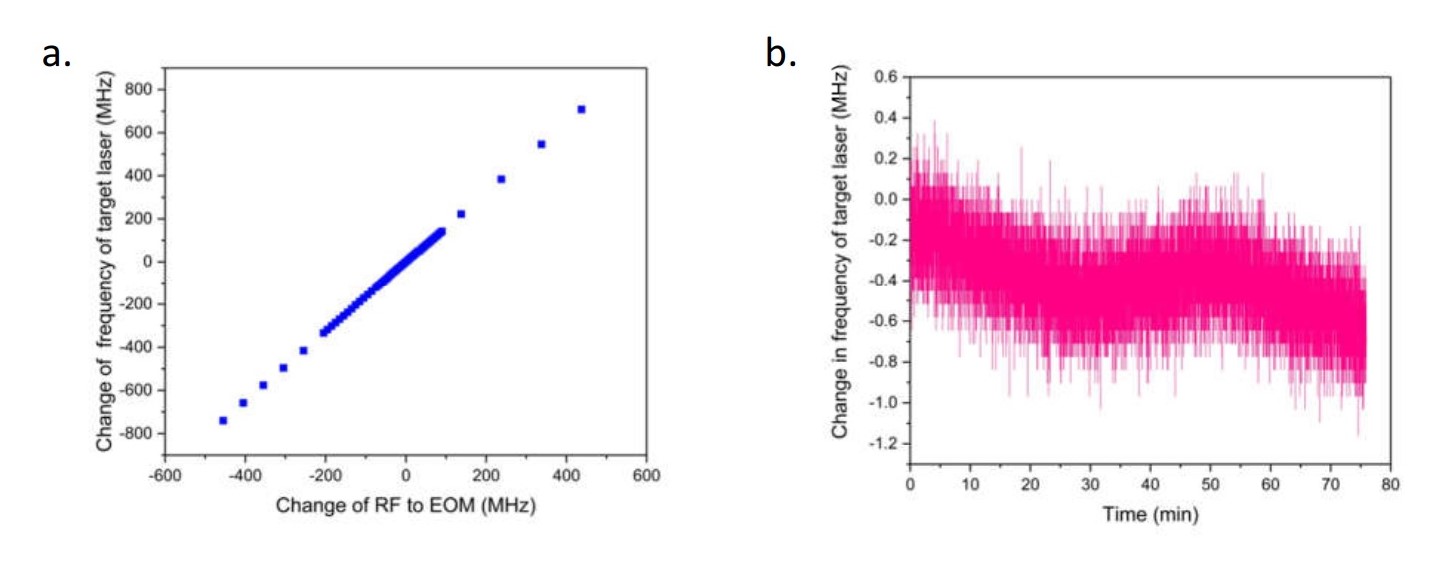
.
Publication:
1.6 GHz frequency scanning of a 482 nm laser stabilized using electromagnetically induced transparency
KP Subramonian Rajasree, K Karlsson, T Ray and S Nic Chormaic
Photon. Technol. Lett. 33, 780 (2021)
3.5 Detection of the transverse spin of light by twisting anisotropic particles near an optical nanofiber waveguide
In contrast to paraxial waves, strongly confined light can carry significant transverse spin angular momentum. Here we reported on its direct detection in the evanescent electromagnetic field near the ultrathin waist of an optical nanofiber waveguide. We demonstrated the spin by its contribution to rotation of an anisotropic microsphere held and spun near the nanofiber waist by optical tweezers. By setting the driving spin angular momentum in the optical tweezers to be parallel or antiparallel with respect to the transverse spin near the nanofiber, we could speed up or slow down the particle’s rotation by about a half of the rotation rate observed without the light in the fiber, Fig. 3.
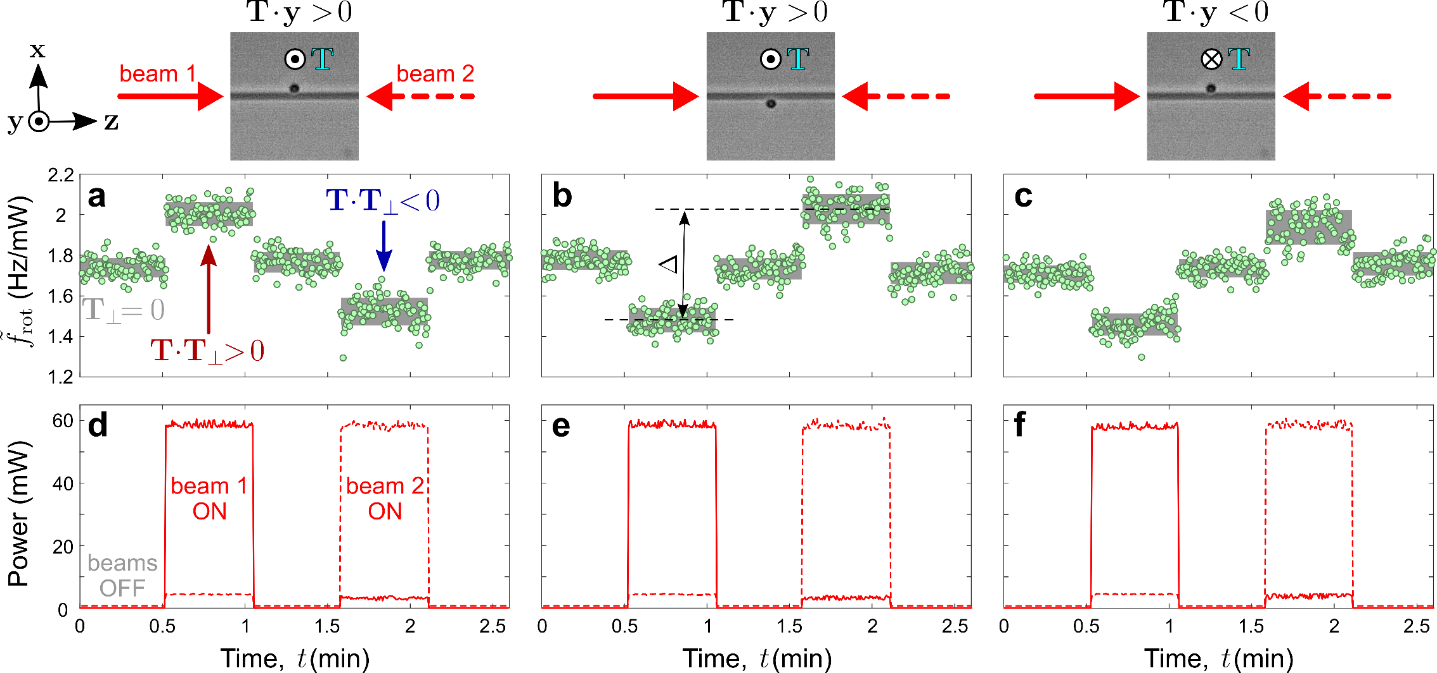
Figure 3: (Top) An anisotropic microsphere (bipolar nematic liquid crystal droplet) in water was trapped by optical tweezers near an optical nanofiber. The spin angular momentum transferred from the tweezers beam resulted in the optical torque, T, parallel to the axis y. The evanescent field crated near the nanofiber by one of the coupled laser beams (1 or 2) carried a transverse spin angular momentum which could be transferred to the particle by scattering of light. Since the transverse spin locks to the propagation direction of the fiber mode, the resultant optical torque, T⊥, was parallel to T for beam 1 or antiparallel for beam 2. (a, b) Experimental demonstration of the increase and decrease of particle’s rotation frequency due to the action of the transverse spin of light.
Publication:
Detection of the transverse spin of light by twisting anisotropic particles near an optical nanofiber waveguide
G Tkachenko, I Toftul, A Vylegzhanin, VG Truong, M Petrov and S Nic Chormaic
Proc. SPIE 11926, Optical Manipulation and Structured Materials Conference 2021, 119260R (27 October 2021)
4. Publications
4.1 Journals
- Kumar, A., Asadollahbaik, A., Kim, J., Lahlil, K., Thiele, S., Herkommer, A., Nic Chormaic, S., Kim, J., Gacoin, T., Giessen, H. and Fick, J. Emission spectroscopy of NaYF4:Eu nanorods optically trapped by Fresnel lens fibers.* Photonics Res. 10, 332-339, doi: https://doi.org/10.1364/PRJ.434645 (2022).
- Yu, D., Humar, M., Meserve, K., Bailey, R., Nic Chormaic, S. and Vollmer, F. Whispering-gallery-mode sensors for biological and physical sensing. Nat. Rev. Methods Primers 1, 83, doi: https://doi.org/10.1038/s43586-021-00079-2 (2021)
- Tkachenko, G., Toftul, I., Vylegzhanin, A., Truong, VG., Petrov, M. and Nic Chormaic, S. Detection of the transverse spin of light by twisting anisotropic particles near an optical nanofiber waveguide. Proc. SPIE 11926, Optical Manipulation and Structured Materials Conference 2021. 119260R (27 October 2021), doi: https://doi.org/10.1117/12.2616130 (2021)
- Kotsifaki, DG., Ripken, C. and Nic Chormaic, S. Analysis of small plastics in coastal surface water samples of Okinawa using optical tweezers-Raman spectroscopy. Proc. SPIE 11926, Optical Manipulation and Structured Materials Conference 2021. 119260J (27 October 2021), doi: https://doi.org/10.1117/12.2616110 (2021)
- Liu, D., Li, W., Wu, Q., Zhao, H., Ling, F., Tian, K., Shen, C., Han, W., Wei, F., Farrell, G., Semenova, Y. and Wang, P. High sensitivity liquid level sensor for microfluidic applications using a hollow core fiber structure.* Sens. Actuator A. Phys. 332, 113134, doi: https://doi.org/10.1016/j.sna.2021.113134 (2021)
- Zhang, M., Wang, R., Tian, K., Brambilla, G., Yuan, L. and Wang, P. Optical detection of ammonia in water using integrated up-conversion fluorescence in a fiberized microsphere.* J. Lightwave Technol. 39, 7303, doi: https://doi.org/ 10.1109/JLT.2021.3111829 (2021)
- Kotsifaki, DG., Ripken, C. and Nic Chormaic, S. Raman optical tweezers for microplastic pollution identification in the surface waters of Okinawa. Proc. SPIE 11798, Optical Trapping and Optical Manipulation XVIII. 1179829 (1 August 2021), doi: https://doi.org/10.1117/12.2593672 (2021)
- Subramonian Rajasree, KP., Karlsson, K., Ray, T. and Nic Chormaic, S. 1.6 GHz frequency scanning of a 482 nm laser stabilized using electromagnetically induced transparency. Photon. Technol. Lett. 33, 780, doi: https://doi.org/10.1109/LPT.2021.3092316 (2021)
- Kien, F.L., Nic Chormaic, S. and Busch, T. Optical trap for an atom around the midpoint between two coupled identical parallel optical nanofibers. Phys. Rev. A, 103, 063106, doi: https://doi.org/10.1103/PhysRevA.103.063106 (2021) Editors' Suggestion
- Li, A., Tian, K., Yu, J., Minz, RA., Ward, J., Mondal, S., Wang, P. and Nic Chormaic, S. Packaged whispering gallery resonator device based on an optical nanoantenna coupler. Opt. Express. 29, 16879, doi: https://doi.org/10.1364/OE.422830 (2021)
- Kotsifaki, DG., Truong, VG. and Nic Chormaic, S. Giant optical force using an array of asymmetric split-ring plasmonic nanostructures. Proc. SPIE 11701, Complex Light and Optical Forces XV. 1170113 (6 March 2021), doi: https://doi.org/10.1117/12.2579876 (2021)
- Kien, F.L., Ruks, L., Nic Chormaic, S. and Busch, T. Spatial distributions of the fields in guided normal modes of two coupled parallel nanofibers. New J. Phys. 23, 043006, doi: https://doi.org/10.1088/1367-2630/abea44 (2021)
*main work done outside OIST
4.3 Books and other one-time publications
- Plasmon-enhanced optical forces and tweezers
Kotsifaki, DG., Truong, VG. and Nic Chormaic, S.
in Plasmon-Enhanced Light-Matter Interactions (eds. P Yu, H Xu, ZM Wang), Springer Lect. Notes Nanoscale Sci. (LNNST, volume 31), https://doi.org/10.1007/978-3-030-87544-2.
4.4 Oral and Poster Presentations
- Nic Chormaic, S. Engineering whispering gallery resonators for nolinear optics, photonics, and sensing applications (invited talk): WOMA 2022 (online), 07 February (2022)
- Nic Chormaic, S., Hogan, L., Horak, E., Karlsson, K., Ward, J., Goldsmith, R. Microbubble optical resonators for nanoparticle monitoring and control (invited talk): Pacifichem 2021 (online), 17 December (2021).
- Nic Chormaic, S., Kotsifaki, DG., Bouloumis, T., Truong, VG. Plasmonic and metasurface arrays in Au thin films for nanoparticle trapping (invited talk): Pacifichem 2021 (online), 16 December (2021).
- Tkachenko, G. Ultrathin optical fibers and their applications (invited talk): 1st Iranian Conference on Optical Fiber Sensors ICOFS 2021 (online), 28 October (2021).
- Kotsifaki, DG., Ripken, C. and Nic Chormaic, S. Detection and analysis of microplastics in the subtropical ocean of Okinawa using micro-Raman Optical Tweezers (invited talk): MetroSea 2021 (online), 05 October (2021).
- Tkachenko, G., Toftul, I., Vylegzhanin, A., Truong, VG., Petrov, MI. and Nic Chormaic, S. Detection of the transverse spin of light by twisting anisotropic particles near an optical nanofiber waveguide (contributed talk): METANANO 2021 (online), 15 September (2021).
- Nic Chormaic, S. Optical nanofibre mediated near-field interactions with cold rubidium atom (contributed talk): METANANO 2021 (online), 15 September (2021).
- Li, S. and Nic Chormaic, S. From microbottles to nanocapillaries: Light-matter interactions in the strong scattering regime enabled by the reduced dimensionality (contributed talk): METANANO 2021 (online), 14 September (2021).
- Nic Chormaic, S. Optomechanical manipulation using optical nanofibres (invited talk): METANANO 2021 (online), 14 September (2021).
- Gupta, R., Everett, J., Tranter, A., Gokhroo, V., Lam, PK. and Nic Chormaic, S. Machine learning based optimization of an optical nanofiber evanescent dipole rubidium trap (contributed talk): QuAMP 2021 (online), 3 September (2021).
- Nic Chormaic, S. Optical fiber-based traps for particle trapping, manipulation and characterization (invited talk): SPIE Optics & Photonics: Optical Trapping and Optical Manipulation XVIII, Online, San Diego, USA, 1-5 August (2021).
- Bouloumis, T., Kotsifaki, DG., Truong, VG. and Nic Chormaic, S. Metamaterial tweezers for super-efficient nanoparticle trapping (contributed talk): SPIE Optics & Photonics: Optical Trapping and Optical Manipulation XVIII, Online, San Diego, USA, 1-5 August (2021).
- Kotsifaki, DG., Ripken, C. and Nic Chormaic, S. Raman optical tweezers for microplastic pollution identification in the surface waters of Okinawa (contributed talk): SPIE Optics & Photonics: Optical Trapping and Optical Manipulation XVIII, Online, San Diego, USA, 1-5 August (2021).
- Bathish, B., Hyams, I., Kreps, S., Douvidzon, ML., Lei, F., Ward, J., Kasumie, S., Nic Chormaic, S., Cohen, O., Gad, R. and Carmon, T. Plasma-filled optical microcavities (poster): 2021 CLEO Europe and EQEC, OSA Technical Digest (Optical Society of America, 2021), paper cg_p_20, 21-25 June (2021).
- Nic Chormaic, S. Ultrathin fibres and whispering gallery resonators: basics, particle trapping and beyond (plenary talk): ICLLT-2, Online, Turkey, 28 May (2021).
- Nic Chormaic, S. Using optical fibers for particle trapping and manipulation (invited talk): OMC2021, Online, Japan, 22 April (2021).
- Tkachenko, G., Toftul, I, Vylegzhanin, A., Truong, VG., Petrov, M. and Nic Chormaic, S. Detection of the transverse spin of light by twisting anisotropic particles near an optical nanofiber waveguide (contributed talk): OMC2021, Online, Japan, 21 April (2021).
- Kotsifaki, DG., Ripken, C. and Nic Chormaic, S. Analysis of small plastics in coastal surface water samples of Okinawa using optical tweezers-Raman spectroscopy (contributed talk): OMC2021, Online, Japan, 21 April (2021).
- Nic Chormaic, S. Using optical fibers for particle trapping and manipulation (contributed talk): Biophotonics Congress: Optics in the Life Sciences Online, 15 April (2021).
- Kotsifaki, DG. Optical trapping and manipulation of nanoparticles using an array of plasmonic nanocavities (invited talk): Biophotonics Congress: Optics in the Life Sciences Online, 15 April (2021).
4.5 Seminar (outside OIST)
- Nic Chormaic, S. Manipulating and trapping particles using evanescent light fields (seminar): School of Physical Sciences, DCU Dublin, Ireland, 24 February (2022).
- Vylegzhanin, A. and Brown, D. Rydberg atom interactions near an optical nanofiber (seminar): Ohmori Group, Institute for Molecular Science, Aichi, Japan, 14 December (2021).
- Nic Chormaic, S. Ultrathin optical fibre applications from atomic physics through quantum optics (online seminar): School of Physics, Trinity College Dublin, Ireland, 08 October (2021).
- Nic Chormaic, S. Particle trapping and spectroscopy using ultrathin optical fibres and whispering gallery resonators (online seminar). SPIE Visiting Lecturer, National Institute of Technology, Warangal, India, 9 April (2021).
5. Intellectual Property Rights and Other Specific Achievements
US Provisional Patent Application No. 63/306,553 filed on February 4, 2022 on "Laser based on a dielectric resonator with gas or plasma at population inverstion" , Tal Carmon, Raanan Gad and Sile Nic Chormaic (c/o Ramot at Tel-Aviv University, Israel).
6. Meetings and Events
6.1 Seminar (online: Optics Seminar OIST)
- Title: Engineering light-matter interactions for optical nanotweezers and for chip-scale infrared microspectrometers
- Date: April 14, 2021
- Speaker: Prof. Kenneth Crozier ( The University of Melbourne, Australia)
6.2 Research Visit
Nothing to report due to COVID restrictions
7. Other
Mr. Theodoros Bouloumis (PhD student) was awarded a 2021 Optics and Photonics Education Scholarship by SPIE, the international society for optics and photonics, for his potential contributions to the field of optics, photonics or related field.
Mr. Theodoros Bouloumis (PhD student) was awarded a JSPS DC2 Fellowship.
Prof. Nic Chormaic assumed the following roles:
- Editorial Board Member for SPIE's Advanced Photonics
- Editorial Advisory Board Member for AVS Quantum Science (AQS)
- COST International Partner Country Representive for project CA16221 - Quantum Technologies with Ultracold Atoms.
- Program Chair for the Optica Life Sciences Conference: Optical Manipulation Applications (online) in April 2021.
- Committee Member for the SPIE Structured Light Conference: OMC (online) in April 2021.
- Committee Member for the ICNN 2021 (online) Conference.
- Global Representative for JSAP.
- Optica/DPG Herbert Walter Award Committee Chair
Prof. Nic Chormaic won funding from the Rita R. Colwell Impact Fund (OIST Foundation).
Drs Dylan Brown and Ke Tian won JSPS KAKENHI grants.
Prof. Nic Chormaic featured in an OSA podcast on diversity in optics where she discussed the initiatives taken by OIST.
Prof. Nic Chormaic spent three months (Jan-March 2022) working in the LPGP at the Universite Paris-Saclay through the LabEX PALM visitor programme.



